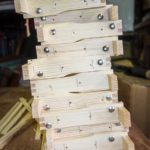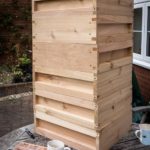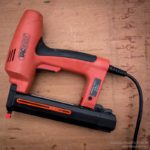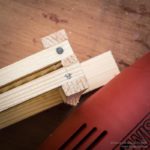Nail guns
Putting frames together is one of those tasks that should be undertaken in the dark days of winter when it can be done at a leisurely pace. There’s a certain satisfaction from the mindless repetition of the process, whether for standard frames with foundation or foundationless frames (with the latter requiring a bit more effort due to the drilling and ‘wiring’ necessary). However, it’s cold in the winter and there’s certainly no satisfaction from bashing the end of your thumb with the hammer. Your fingers are semi-numb with cold, barely able to grip the gimp pin, which is too small to hold in a gloved hand. Self-harm is almost inevitable.
Of course, in the summer, if you need more frames you need them yesterday. There’s nothing leisurely about it. There’s a flow on, the supers are filling faster than you can keep up, the bait hive has been occupied by a swarm and you need to set another up or you urgently need a dozen new frames so you can move the nucs to full brood boxes. With nucs being sold, swarm control and 8-10 honey producing colonies I get through a lot of new frames each season. I’ve not counted, but do know I’ve used nearly a full 100 metre spool of 15kg monofilament making foundationless brood frames alone, each using about a metre of nylon.
I needed six new supers with frames for the weekend inspection. There’s a good flow on, possibly lime, and I’ve more or less run out of boxes. Constructing the supers from flat-packed seconds bought in the winter sales was a trivial job. Knocking together the ~60 frames I needed to populate them also turned out to be quick and easy as I’d generously been given a Tacwise EL 191 Pro nail gun. This is a light duty electric model, using 18g nails from 10-35mm or type 91 staples from 15-30mm. This was the first time I’d used it for building frames. What a revelation!
The usual incessant tap, tap, tap (or, at best, tap, tap) for each of the 8 gimp pins in a frame was replaced with a satisfying ‘chunk’ as the nail gun drove the galvanised 20mm pin flush with the surface. It didn’t take long to get the positioning accurate and adding the six pins (four on the top bar and two holding one of the bottom bars in place) took less than 15 seconds. Most of the frames ended up with thin unwired foundation for cut comb so I fitted the second bottom bar with standard gimp pins. This is necessary as they are easy to remove (and I’ll need to add fresh foundation next season), whereas the nails driven by the nail gun are almost impossible to shift once they’re driven in flush.
Since the nail gun is essentially single handed there’s no chance (well, almost no chance) of injuring my thumb. I might even be able to use it with gloves on in the winter.
I now need to order some 18g 35mm nails – the largest this model takes – for building boxes ?




Join the discussion ...